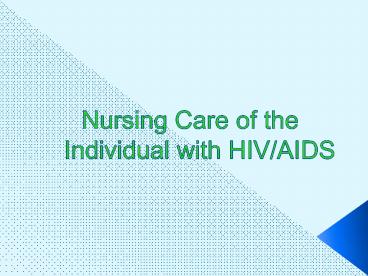Nursing Care of the Individual with HIV/AIDS PowerPoint PPT Presentation
1 / 36
Title: Nursing Care of the Individual with HIV/AIDS
1
Nursing Care of the Individual with HIV/AIDS
2
What is HIV?
3
Transmission
- What is the most common mode of HIV transmission?
- How else is HIV transmitted?
- What is the most common mode of work related
transmission?
p. 241
4
How is HIV transmitted? Select all that
apply.
- Vaginal secretions
- Kissing
- Semen
- Urine and feces
- Breast milk
- Coughing, sneezing
- Using the same comb as person with HIV
5
HIV / AIDS
- What is the main receptor to which the HIV virus
must bind in order to gain entry into the hosts
body?
6
Pathophysiology
- Viruses cannot reproduce /replicate without a
host, what is the host, target cell for HIV? - What is the function of T-cells?
- The normal CD4 cell count in an adult is ______?
7
HIV / AIDS
- What is the difference between HIV and AIDS?
- How long does it take for HIV to become AIDS?
8
When is a person said To have AIDS?
9
Timeline for Untreated Illness
10
Signs and Symptoms
- Flu-like symptoms
- Fatigue
- Sore throat
- Enlarged lymph nodes
- Headache
- Muscle and joint pain
- Goes through stages
11
Oral Hairy Leukoplakia
Which stage does this occur?
12
Signs and Symptoms
- Swollen lymph glands
- Thrush
- Muscle and joint pain
- Low-grade fever
- Oral hairy leukoplakia
- Sore Throat
- CD4 T cells drop to 200 to 500 cells/µl
- Localized infections
- Acute Stage
- Early Chronic
- Intermediate Chronic
- Late Chronic/ AIDS
13
Diagnosis
What is major problem rt diagnosis?
14
Acquired Immunodeficiency Syndrome (AIDS)
- Diagnostic CDC criteria
- CD4 T cell count below 200 cells/µl
- Specific opportunistic infection or cancer
- Wasting syndrome
- AIDS dementia complex (ADC)
- Must meet CDC criteria outlined in Table 15-10 in
textbook
15
What tests are used in diagnosis
- Enzyme immunoassay (EIA) to detect serum
antibodies - If test is negative what do they do?
- If test is positive what do they do?
- If re-test is positive what do they do?
- A confirming test (Western blot)
- If this test is positive reported as
16
Testing used to Monitor Treatment Effectiveness
- Progression monitored by
- CD4 T cell counts
- viral load
- Abnormal blood tests common
- Neutropenia, thrombocytopenia, and anemia
17
HIV Viral Load
- Measures amount of HIV specific RNA,
- Viral load correlates strongly with stage of
disease
- HIV RNA levels during course of infection
- or at the time of seroconversion 5 million
copies - 5 yrs 25, 000 copies
- 8 yrs 300,000 copies
18
What is the Major Goal of Care?
19
Treatment and Nursing Care
20
HAART - Highly Active Antiretroviral Therapy
- When should Therapy be Started?
21
Antiretroviral Therapy
- Adherence to drug regimens is critical to prevent
- Disease progression
- Opportunistic disease
- Viral drug resistance
22
Antiretroviral Therapy
- Non-nucleoside reverse transcriptase inhibitor
(NNRTIs) ex efavirenz (sustiva) - Nucleoside/nucleotide reverse transcriptase
inhibitor (NRTIs/NtRT) - ex zidovudine (retrovir, AZT,
- SDV), tenovir DF (viread, TDF)
- Work by inhibiting viral replication
23
Antiretroviral Therapy
- Protease inhibitors disable protease, a protein
that HIV needs to make more copies of itself ex
darunavir (prezista) - Entry/Fusion inhibitors blocks HIV entry into
cells ex enfuvirtide (FuzeonT-20)
24
Antiretroviral Therapy
- Integrase inhibitors disable integrase, a
protein that HIV uses to insert its viral genetic
material into that of the infected cell ex
raltegravir (isentress) - Fixed dose combination contain 2 or more meds
from 1 or more drug classes - ex.- efavirenz, tenofovir (atripla)
25
Side Effects Toxicities
- Common physical problems
- Depression
- Diarrhea
- Peripheral neuropathy
- Pain
- Nausea/vomiting
- Fatigue
26
Side Effects Toxicities
- Common metabolic disorders
- Lipodystrophy
- Hyperlipidemia
- Insulin resistance
- Bone disease
- Lactic acidosis
- Cardiovascular disease
27
- If the side effects occur what would the nurse
expect to happen next?
28
Medication Therapy
- What is the major problem encountered in treating
with ART primarily when one drug alone is being
used? - What to do about it?
29
What strategies are Used to improve adherence To
ART?
30
- How would the nurse know that ART is effective?
31
Summary of Opportunistic Infections
32
Health Promotion / Prevention
- Major goal Prevention
- Four CDC strategies
- Use testing as routine health care
- Use rapid testing
- Work to modify risky behaviors
- Offer tests universally to pregnant women
33
Health Promotion/ Prevention
- What is important to teach to decrease the risk
of spread via - Sexual intercourse?
- Drug use?
- Perinatal transmission?
34
Nursing Care
- Ways to promote a healthy immune system (slow
disease progression) - Nutritional support
- Moderation or elimination of alcohol, tobacco,
and drug use - Mental health counseling
- Vaccines
- Rest, exercise, and stress reduction
- Avoid exposure to infectious agents
35
HIV Transmission to Healthcare Workers
- Source of
Exposure HIV
- Needlesticks (open bore needle) or cuts
- Skin contact (intact)
- Splashes in mucous membrane
- (eye, nose or mouth)
- 0.3-0.4
- lt0.1
- 0.1
36
And the research continues
- The End

